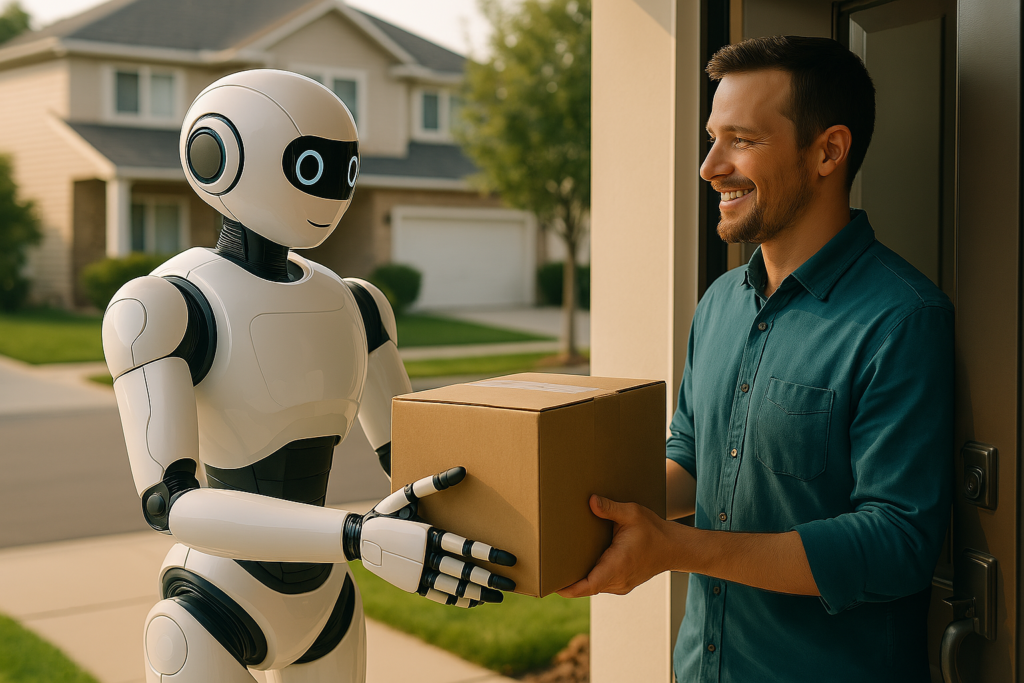In-short:
- Amazon is developing delivery-centric humanoid robots and testing them in a dedicated facility known as a “humanoid park.”
- These robots are designed to perform complex delivery and logistics tasks, mimicking human motion and handling capabilities.
- The initiative reflects Amazon’s broader push toward full-spectrum automation in its operations.
- The technology is being developed in a way that balances innovation with job displacement concerns.
Introduction
Imagine a world where your online order arrives not via a delivery person, but through a humanoid robot that walks to your doorstep. Amazon, the global e-commerce and logistics behemoth, is inching closer to making this scenario a reality. The company is reportedly developing advanced delivery-focused humanoid robots and testing them in a specialized environment known as a “humanoid park.”
This blog takes a deep dive into Amazon’s ambitious robotic automation program, examining the motivations, technologies, implications, and challenges involved. As always, the goal is to deliver clear, research-backed insights written in an accessible tone.
The Rise of Humanoids in Last-Mile Delivery
Humanoid robots differ from traditional robots due to their human-like structure and mobility. Unlike warehouse robots that move along predetermined tracks, humanoids can:
- Navigate irregular terrains (stairs, curbs, porches)
- Open doors and handle packages of varying sizes
- Interact with humans (customers, pets, or delivery personnel)
Amazon’s decision to develop such robots points to a significant evolution from automation confined to sorting centers and warehouses to the very last stage of the supply chain: the customer’s doorstep.
What is a ‘Humanoid Park’ and Why It Matters
The term “humanoid park” refers to a controlled testing environment designed to simulate real-world delivery conditions. This includes:
- Mock neighborhoods
- Staircases, fences, and doors
- Obstacles like toys, bicycles, and pets
- Varying weather simulations (rain, snow, heat)
These parks allow engineers to refine robot navigation, object handling, and real-time problem-solving under complex, unpredictable circumstances. The simulation is key to developing reliability and safety in humanoid deployment.
Tech Under the Hood: How These Robots Work
Amazon’s humanoid robots incorporate multiple advanced technologies:
- Computer Vision and LIDAR: For environment mapping and object recognition
- AI and Machine Learning: To make autonomous decisions
- Haptic Feedback Sensors: For delicate object manipulation
- Natural Language Processing: For human interaction if needed
- Cloud-Connected Brain: Centralized learning from all robot units
Some prototypes even feature emotion-recognition abilities to gauge human responses and adjust their behavior accordingly.
Why Amazon Is Investing Heavily in Humanoid Robots

Several strategic goals drive this investment:
- Cost Efficiency: Reducing labor costs in the long term
- 24/7 Operations: Robots don’t need sleep, breaks, or benefits
- Increased Delivery Speed: Especially in urban or high-demand areas
- Customer Satisfaction: Ensuring timely and reliable delivery regardless of workforce shortages
Moreover, Amazon has been facing increasing scrutiny over working conditions, labor strikes, and unionization efforts. Automation offers a long-term mitigation strategy.
Economic Implications: The Workforce and the Wallet
While humanoid robots may eventually replace some human roles, experts argue that this shift could:
- Create new jobs in robot maintenance, AI development, and operations
- Displace lower-wage roles, especially in delivery and logistics
- Impact gig economy workers like Amazon Flex drivers
Balanced policies and training programs will be crucial to avoid large-scale unemployment.
Ethical and Societal Considerations
Introducing humanoid robots into public spaces comes with ethical concerns:
- Surveillance and Privacy: Many robots use cameras and microphones
- Human Interaction: How comfortable are people interacting with machines?
- Security: What if robots are hacked or malfunction?
Amazon will need to work closely with regulators, ethicists, and communities to ensure responsible deployment.
Comparative Global Landscape: Who Else Is Doing This?
Amazon isn’t alone in this quest:
- Agility Robotics has developed “Digit,” a humanoid for logistics
- Tesla is working on “Optimus,” a general-purpose humanoid
- China’s UBTech and Unitree are building versatile bipedal machines
However, Amazon’s edge lies in its massive logistics infrastructure, which could rapidly absorb and scale robotic solutions.
Limitations and Technical Challenges
Despite their promise, humanoid robots face hurdles:
- Battery Life: Limited range and operating time
- Mobility in Real Conditions: Slippery, wet, or uneven terrains
- Package Size Limits: Not all items can be handled by a robot
- Public Acceptance: Social resistance to machine presence
Continuous iterations and public education will be critical.
The Future of Human-Robot Collaboration in Logistics
The future likely isn’t fully robotic or fully human—it’s collaborative. Picture:
- Humanoids handling door-to-door deliveries
- Drones assisting with aerial package drops
- Humans managing exceptions, tech support, and robot fleet logistics
Amazon is setting the stage for this hybrid logistics future.
Conclusion: Automation or Augmentation?
Amazon’s development of humanoid delivery robots is more than a technical marvel—it represents a shift in how we think about labor, logistics, and human-machine interaction. While it raises valid concerns about employment and ethics, it also offers unprecedented efficiency, safety, and convenience.
As the humanoids trained in their “parks” prepare for real-world deployment, society must gear up for a future where your delivery might just walk up and smile at you—robotically, of course.









+ There are no comments
Add yours